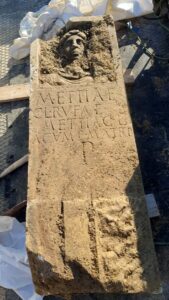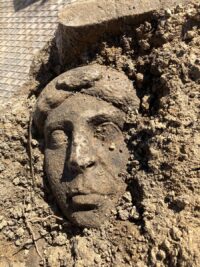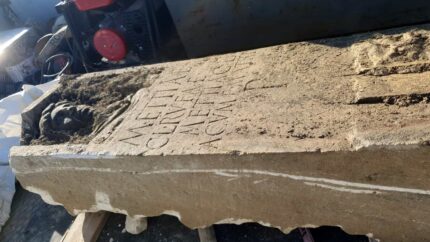 A funerary stele from the Roman imperial era with a high-relief portrait of the deceased has been discovered in the hill town of Bucchianico in south central Italy’s Abruzzo region. The stone slab came to light during construction of a roundabout, spotted by the archaeologist supervising the work crew. It does not appear to have been found in its original location. It was likely displaced from the burial it was marking in antiquity or it may have been a secondary burial. Archaeologists will return to excavate the find site thoroughly in the hopes of finding traces of the grave.
A funerary stele from the Roman imperial era with a high-relief portrait of the deceased has been discovered in the hill town of Bucchianico in south central Italy’s Abruzzo region. The stone slab came to light during construction of a roundabout, spotted by the archaeologist supervising the work crew. It does not appear to have been found in its original location. It was likely displaced from the burial it was marking in antiquity or it may have been a secondary burial. Archaeologists will return to excavate the find site thoroughly in the hopes of finding traces of the grave.
The inscription reads:
METTIAE
C L RVFAE
METTIA C L
ACVME MATRI
P
Which approximately translates (with likely interpolations for the abbreviations) to:
To Mettia Rufa, freedwoman of Caius,
Mettia, freedwoman of Caius,
places this for her mother.
 The Mettii were a prominent plebian family in the early imperial era. Originally from southern Italy a couple of regions down the boot from Abruzzo, the family rose in importance in the late Republic. Marcus Mettius was a legate of Julius Caesar’s in 58 B.C. The first Mettius to attain the rank of consul was appointed by the emperor Vespasian (r. 69-79 A.D.) Another three followed, giving the Mettii four consuls on their family track record between the 70s and 128 A.D. The one appointed in 103 A.D. was a Gaius (or Caius), Gaius Trebonius Proculus Mettius Modestus, although of course there’s no way of knowing if he was the former owner of the freedwoman Mettia Rufa as Roman families used the same handful of first names over and over again.
The Mettii were a prominent plebian family in the early imperial era. Originally from southern Italy a couple of regions down the boot from Abruzzo, the family rose in importance in the late Republic. Marcus Mettius was a legate of Julius Caesar’s in 58 B.C. The first Mettius to attain the rank of consul was appointed by the emperor Vespasian (r. 69-79 A.D.) Another three followed, giving the Mettii four consuls on their family track record between the 70s and 128 A.D. The one appointed in 103 A.D. was a Gaius (or Caius), Gaius Trebonius Proculus Mettius Modestus, although of course there’s no way of knowing if he was the former owner of the freedwoman Mettia Rufa as Roman families used the same handful of first names over and over again.
Archaeological remains from the Roman era have been found before in the area where the stele was unearthed (hence the archaeological supervision). The hilltop itself housed a sanctuary of Hercules and the country homes of notable families were built in the environs. The burial ground of one of those families, the Aufidi, was discovered in 1836.
The stele will be transported to Sulmona where the Superintendency of Archaeology, Fine Arts and Landscape of the provinces of Chieti and Pescara have an appropriate facility to perform the necessary cleaning and conservation. While experts work on the stone, Bucchianico municipal officials will be raising funds for the restoration and eventual display back in the town where it was discovered, perhaps in the cloister of the municipal palace.

Supervision? The slab is clearly damaged by the heavy machinery
It seems indeed as if “Rufa” had been one of C. Mettius’ slaves, and judging by her name, she could have had “red” hair. A ‘dissaeptum orbiculatum’ or circular gateway could have been familiar to her.
Of course, it is hard to tell if Mr. ‘Caius Trebonius Proculus Mettius Modestus’ might have had business dealings with red hair nations, but maybe he had some with the surroundings of what is today Bucchianico.
What does the giant P stand for?
“METTIA ACUME(N) MATRI P(ONEBAT)”? = Mettia pointed/erected this to her mother.